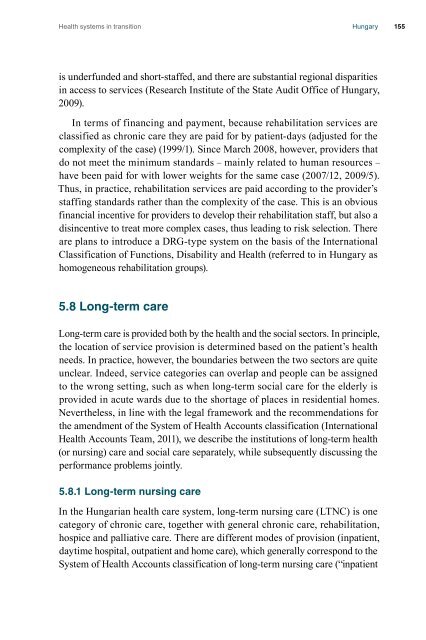Health Systems in Transition - Hungary - World Health Organization ...
Health Systems in Transition - Hungary - World Health Organization ...
Health Systems in Transition - Hungary - World Health Organization ...
You also want an ePaper? Increase the reach of your titles
YUMPU automatically turns print PDFs into web optimized ePapers that Google loves.
<strong>Health</strong> systems <strong>in</strong> transition <strong>Hungary</strong> 155<br />
is underfunded and short-staffed, and there are substantial regional disparities<br />
<strong>in</strong> access to services (Research Institute of the State Audit Office of <strong>Hungary</strong>,<br />
2009).<br />
In terms of f<strong>in</strong>anc<strong>in</strong>g and payment, because rehabilitation services are<br />
classified as chronic care they are paid for by patient-days (adjusted for the<br />
complexity of the case) (1999/1). S<strong>in</strong>ce March 2008, however, providers that<br />
do not meet the m<strong>in</strong>imum standards – ma<strong>in</strong>ly related to human resources –<br />
have been paid for with lower weights for the same case (2007/12, 2009/5).<br />
Thus, <strong>in</strong> practice, rehabilitation services are paid accord<strong>in</strong>g to the provider’s<br />
staff<strong>in</strong>g standards rather than the complexity of the case. This is an obvious<br />
f<strong>in</strong>ancial <strong>in</strong>centive for providers to develop their rehabilitation staff, but also a<br />
dis<strong>in</strong>centive to treat more complex cases, thus lead<strong>in</strong>g to risk selection. There<br />
are plans to <strong>in</strong>troduce a DRG-type system on the basis of the International<br />
Classification of Functions, Disability and <strong>Health</strong> (referred to <strong>in</strong> <strong>Hungary</strong> as<br />
homogeneous rehabilitation groups).<br />
5.8 Long-term care<br />
Long-term care is provided both by the health and the social sectors. In pr<strong>in</strong>ciple,<br />
the location of service provision is determ<strong>in</strong>ed based on the patient’s health<br />
needs. In practice, however, the boundaries between the two sectors are quite<br />
unclear. Indeed, service categories can overlap and people can be assigned<br />
to the wrong sett<strong>in</strong>g, such as when long-term social care for the elderly is<br />
provided <strong>in</strong> acute wards due to the shortage of places <strong>in</strong> residential homes.<br />
Nevertheless, <strong>in</strong> l<strong>in</strong>e with the legal framework and the recommendations for<br />
the amendment of the System of <strong>Health</strong> Accounts classification (International<br />
<strong>Health</strong> Accounts Team, 2011), we describe the <strong>in</strong>stitutions of long-term health<br />
(or nurs<strong>in</strong>g) care and social care separately, while subsequently discuss<strong>in</strong>g the<br />
performance problems jo<strong>in</strong>tly.<br />
5.8.1 Long-term nurs<strong>in</strong>g care<br />
In the Hungarian health care system, long-term nurs<strong>in</strong>g care (LTNC) is one<br />
category of chronic care, together with general chronic care, rehabilitation,<br />
hospice and palliative care. There are different modes of provision (<strong>in</strong>patient,<br />
daytime hospital, outpatient and home care), which generally correspond to the<br />
System of <strong>Health</strong> Accounts classification of long-term nurs<strong>in</strong>g care (“<strong>in</strong>patient
















